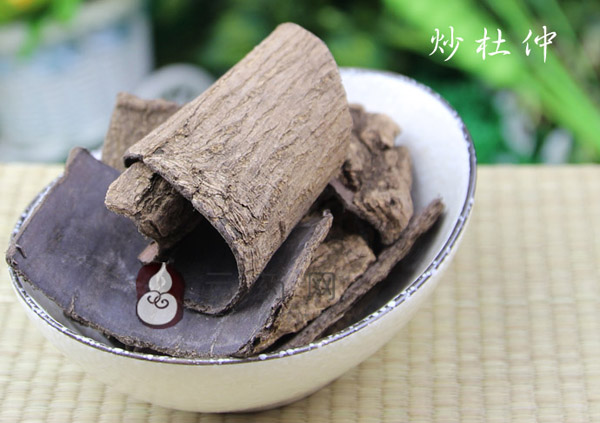Actually it means the dried bark of Eucommia ulmoides Oliv., a plant in the family Eucommiaceae. Its common names include rubber tree bark and cortex eucommiae. For the best medicinal value, Eucommia stem bark is usually harvested from April to June. After the peeling, it needs to scrape off the tertia, stack them together, sweat them till their endothelium become purple-brown, and then dry them in the sun.
Eucommia is a rare tree species surviving from ancient age. So far, as many as 14 species in the entire genus Eucommia has been found all over the world. Unfortunately they have become extinct one after another on the mainland and Europe. That's to say, currently the species in China is the only relict plant survived. As a result, Eucommia ulmoides has not only a high economic value, but also a very important scientific value for the research on the system evolution of angiosperms, the flora origin in China, and so on.
It is a deciduous tree, up to 20 meters high, 50cm in diameter, and with spherical crown. Eucommia ulmoides bark is dark gray. Branches have flaky marrow. All parts show silvery white plastic wire after broken. Branchlets is smooth and with no terminal bud. Eucommia leaf is single, alternate, elliptic, 7 to 14cm long, serrated, pinnately veined, and without stipules. Flowers, growing in bract at the base of young branches, are unisexual, dioecious, and with no perianth. Samara is flat, oblong, 2-lobed at the apex, and with one seed only. It blooms from April to May, along or prior to the blossom of bract. And it fruits from October to November. Main habitat is montane forest. But now most of them are from cultivation and distributed in the middle Yangtze River, the southern provinces, Henan, Shaanxi, Gansu and other places.
EUCOMMIA BARK BENEFITS
This herb has varying degrees of regulation on the immune system, endocrine system, central nervous system, circulatory system and urinary systems. What’s more, it can excite the hypothalamus-pituitary-adrenal cortex system and strengthen the adrenal function. Modern research also found that it works, in the same way with Dang Shen (Codonopsis) and Huang Qi (Astragalus), to support immune function. All these evidences confirm its old assess by the ancient Chinese wisdom – long term usage of Eucommia can help weight loss and rejuvenation.
MODERN PHARMACOLOGICAL ACTIONS
1. Its decoction can significantly reduce the activities of mice;
2. Its decoction can prolong the pentobarbital-induced sleeping time;
3. It can inhibit the delayed-type hypersensitivity induced by DNCB;
4. It can resist hydrocortisone's immunosuppressive effects, shift the balance of cell-mediated immunity, enhance the tumor-bearing mice's ability of increasing glycogen content, and raise blood sugar;
5. All its raw, fried, and sand-scorch decoctions have significant antihypertensive effect to rabbits and dogs. But the raw one has weaker effect. And effect of the other two is almost identical and their absolute value is equal to twice of the raw version; all of them can fight against the effect of hypophysin on isolated uterus – significantly inhibit its spontaneous activity and reduce its frequency and contraction strength.
PROVEN EUCOMMIA BARK RELATED HERBAL FORMULAS
So, what is Eucommia bark used for? Before answering this question, it is necessary to master its properties. In TCM it is considered as sweet and slightly acrid in taste and warm in properties. And it covers two meridians like liver and kidney. Its basic functions are nourishing liver and kidney, strengthening the bones and muscles, and miscarriage prevention. Main Eucommia bark uses include lumbago due to kidney-asthenia, ED (erectile dysfunction), urinary frequency, urinary endless, bleeding during pregnancy, pain in Rheumatoid Arthritis, fetal irritability, recurrent abortion, High Blood Pressure, and other fertility problems. Recommended Eucommia bark dosage is from 6 to 9 grams in decoction.

Eucommia Bark
1) Qing E Wan
Qing E Wan comes from Tai Ping Hui Min He Ji Ju Fang (Formulas of the Peaceful Benevolent Dispensary). This formula is basically used for low back pain due to kidney deficiency or feeble feet and knee. Other major herbal ingredients are Hu Tao Ren (Walnut Nut), Bu Gu Zhi (Psoralea), and more.
2) Du Huo Ji Sheng Tang
Du Huo Ji Sheng Tang comes from Qian Jin Fang (Thousand Pieces of Gold Formulae). This formula is exclusively formulated for Lumbago, cold, and somatic heaviness due to wind-damp. Other main herbs include Du Huo (Angelica Root), Sang Ji Sheng (Mulberry Mistletoe Stem), Huai Niu Xi (Achyranthes Root), Chuan Xiong (Lovage Root), Dong Quai (Dang Gui), and more.
3) Du Zhong San
This formula is from Tai ping sheng hui fang (Taiping Holy Prescriptions for Universal Relief). It is mainly designed for unbearable low back pain. Other major herbs are Dan Shen (Salvia Miltiorrhiza), Szechuan Lovage Root, Xi Xin (Chinese Wild Ginger), and so on.
4) Du Zhong Yin
This prescription is from Sheng Ji Zong Lu (Complete Record of Holy Benevolence). It is primarily used for hypertonicity of the sinews and waist-leg weakness in stroke. The rest important herbs are Szechuan Lovage Root, Fu Zi (Prepared Aconite Root), and so on.

![Diseases, Symptoms, tcm, [tcmwindow.com]](/uploadFile/adImg/2015/11/11/f5cbfcc0-4df5-4646-9b9a-f316651a0199.jpg)





